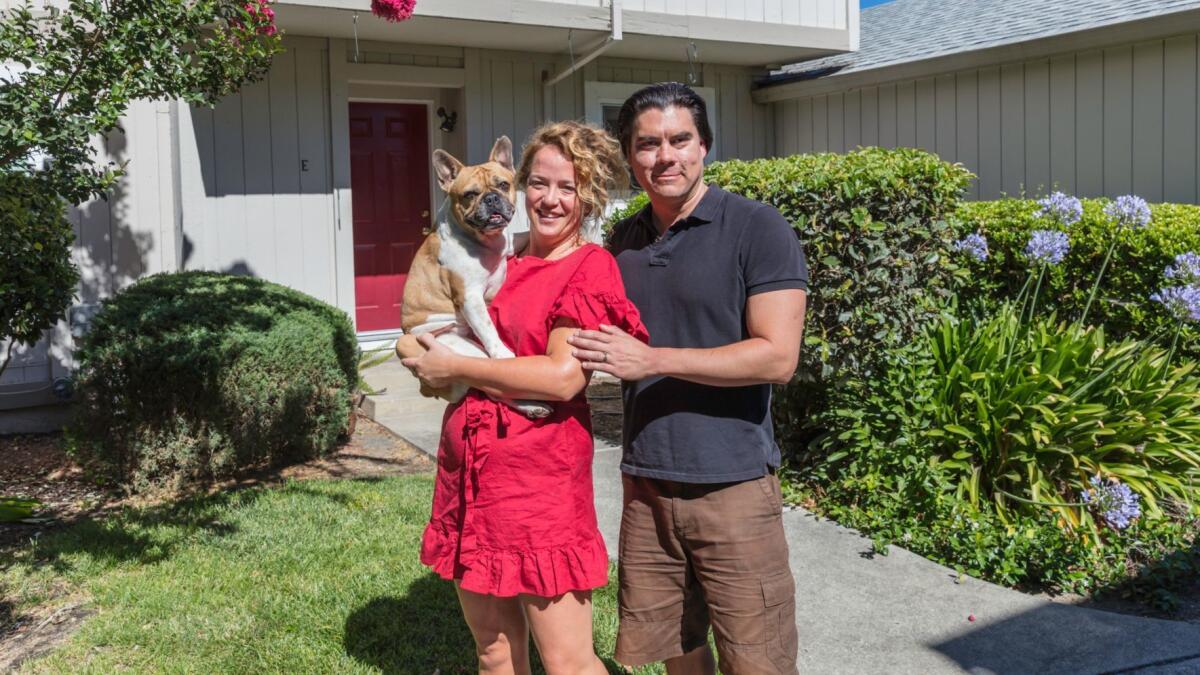As prices rise, mortgage lenders are making it easier to buy a house

Home prices are rising across the country and mortgage rates, though still historically low, are up since the presidential election. (August 4, 2017) (Sign up for our free video newsletter here http://bit.ly/2n6VKPR)
Home prices are rising across the country and mortgage rates, though still historically low, are up since the presidential election.
Simply put, buying a home isn’t easy, especially in high-cost metropolitan areas such as Los Angeles County, where the median price of a home hit $569,000 in June.
But changes in the mortgage industry are afoot, with the goal of loosening some of the strict standards established after the subprime crisis — rules some blame for impeding sales.
“The reality has sunk in that there are buyers out there who will be able to buy homes and make the mortgage payments,” said William E. Brown, the president of the National Assn. of Realtors. The industry is “trying to give them more options to buy a house.”
Government-controlled mortgage giants
The companies, with their congressional mandate to promote home ownership, don’t originate loans, but purchase mortgages from lenders to keep the market moving. And any changes they make in the underwriting standards for the loans they buy can have a big effect.
Also, lenders are moving to relax some standards partly because they fear losing business as home prices and mortgage rates rise, said Guy Cecala, publisher of Inside Mortgage Finance.
“If your business is going to drop 20%,” he said, “you need to come up with ways to offset that.”
The changes bring lending nowhere near the easy-money bonanza of last decade, which ended in financial crisis. But they have brought criticism from some corners that liberalizing rules for down payments and how much debt a borrower can have is a slippery slope that could eventually lead to another bubble.
“This is what happened last time,” said Edward Pinto, a fellow at the American Enterprise Institute, a conservative think tank.
Reduced down payments
During the bubble, borrowers could often put down nothing at all by financing the entire purchase.
After the crash, standards tightened considerably and federal regulators even floated a proposal to require 20% down for many mortgages, which would amount to $113,800 in order to buy a median-priced home in Los Angeles County as of June.
For a low-down-payment option, borrowers usually had to turn to the
Now, borrowers increasingly have more options, though generally they need a good credit score.
The trend started in late 2014 when Fannie Mae and Freddie Mac announced new programs that allowed loans with as little as 3% down. But many large banks still reeling from the housing bust that cost them billions were skeptical.
"I don't think there's a big incentive for us to start to try to create more mortgage availability where the customers are susceptible to default," he told a conference in 2014.
But less than two years later, the bank started offering 3% down loans through a partnership with Freddie Mac.
“We are seeing more and more lenders adopting it every day,” said Danny Gardner, Freddie Mac’s vice president of affordable lending and access to credit.
The 3% down loans through Fannie or Freddie are capped at $424,100 in most of the country, including California.
Bank of America launched its program with Freddie Mac after partnering with a nonprofit to provide financial counseling for the life of the loan, a spokesman said. After six months, BofA upped its annual origination cap from $500 million to $1 billion for the Affordable Loan Solution Program, which allows down payments as low as 3%.
Some are going even lower.
This year, Fannie Mae started pilot programs with some non-bank lenders to offer loans with less than 3% down. The loans require the borrower to have 3% equity, but lenders gift borrowers money to meet the equity threshold as long as the borrower doesn’t eventually pay for it through higher fees or interest rates — which now average about 3.9% for a 30-year fixed loan.
Pilot programs with Guild Mortgage of San Diego and United Wholesale Mortgage of Michigan require the borrower to put down 1% of their own money. A pilot through Movement Mortgage allows a borrower to put down nothing.
Freddie Mac also allows 1% down loans with the lender making a 2% gift, but announced last month it would bar the practice starting in November. Borrowers will still be able to put 1% down if they use money from family or government programs to reach 3% equity.
David Battany, Guild’s executive vice president of capital markets, said it launched its 1% down program to “address the down payment challenge, especially in California.” It was also struggling to compete with lenders that had previously launched very low down payment options.
“We were losing business,” Battany said.
Guild Mortgage’s program was welcomed news for winery owner Mark Blanchard and his wife, Kalle, a nurse.

Despite making a decent living, the couple estimated they would wipe out their savings if they put 20% down on a home in Healdsburg, a Sonoma County town that’s a hot spot for tech workers to purchase a second house.
So this year, they put only 1% down to purchase a more than $400,000, three-bedroom townhouse a short walk from downtown.
“This really was a dream come true for us, as locals, to buy within our own community,” the 38-year-old Blanchard said. “The response from my peers … was how is that possible? How did you buy in this town?”
Debt-to-income ratio
Another recent change affects how much debt a prospective borrower is allowed to carry as a percentage of their gross income.
After the housing crisis, Fannie Mae established a debt-to-income cap of 45%, except for those who put at least 20% down and could show they had enough savings to pay their mortgage for 12 months if they lost their job. Exceptions were also made if a borrower received income from someone who lived in the house, but was not on the loan.
Last month, Fannie did away with those special requirements, raising its cap to 50%.
Freddie Mac said it’s allowed 50% without special exceptions since 2011, but Fannie Mae is larger. A recent analysis by the Urban Institute called Fannie’s new policy “a win for expanding access to credit” and estimated it would lead to 95,000 new loans being approved annually nationwide.
The change is already helping borrowers qualify, said Julie Aragon, a Santa Monica mortgage broker.
“We ran a few [applications] yesterday,” she said Tuesday, a few days after the change went into effect. “They weren’t approved on Friday and got approved [Monday] — one at 48% and another one at 49%.”
Though borrowers with a debt-to-income ratio between 45% and 50% won’t have to meet hard-and-fast requirements, Fannie said they still must prove they are less risky than most, maybe by having a higher credit score.
Freddie Mac also recently launched pilot programs that allow borrowers to use income from household members not on the loan, an effort it said was designed to increase opportunities for Latinos, who often live in multi-generational households.
High prices, student loans put housing out of reach, readers say »
Student Loans
With the exploding cost of higher education causing some students to borrow more than $100,000, several changes are directly targeting young home buyers typically burdened with hundreds, if not thousands, of dollars in monthly student-loan payments.
Among Fannie Mae’s changes:
- If a borrower has some student loans or other non-mortgage debt paid by parents or others, those payments will no longer count toward their debt-to-income ratio.
- Once a borrower becomes a homeowner, Fannie will allow them to qualify for a cheaper cash-out refinance if they use it to pay off their high-interest student loans.
- If a student loan borrower is enrolled in an income-based repayment plan, the lower monthly payment can be used when calculating a debt-to-income ratio. Before, lenders often had to use 1% of the outstanding student loan balance as the monthly payment.
The final change could help people like attorney Chris Blaylock, who said he and his wife earned $150,000 last year but carry roughly $260,000 in student debt.
Blaylock, 30, said they tried to buy a home more than a year ago but gave up when a loan officer expressed surprise at their balances and demanded lots of paperwork.
“My parents got a house at a pretty young age,” he said. “I never thought it would be such a struggle.”
The couple could be paying more than $3,000 a month in student loan payments, Blaylock said, but they have qualified for an income-driven plan that has lowered that to $600. If he’s judged only on his reduced payments, Blaylock thinks he’ll have a better shot.
“It’s possible that could change the equation,” he said.
Another housing bubble?
Last decade lenders often required no documentation and freely dished out loans with risky options such as negative amortization, which kept monthly payments artificially low by allowing the principal balance to rise rather than fall.
Now, because of the Dodd-Frank Act, lenders must ensure borrowers have the ability to repay their mortgages. And many have even stricter underwriting than Fannie and Freddie mandate.
For all the changes, Laurie Goodman of the Urban Institute characterized them as “very marginal.” According to an Urban Institute index loans today are less risky than from 2000 to 2002, a time period when Goodman considered lending standards reasonable.
Cecala of industry publication Inside Mortgage Finance said lenders and Fannie and Freddie are “tinkering” around the edges to get more people into loans, for example by allowing a higher debt-to-income ratio but mandating high credit scores in return.
“In the olden days, you would see loosening across the board,” he said. Now, “it’s moving the needle a little more.”
Cecala also noted the riskiest mortgages during the bubble were not purchased or guaranteed by Fannie and Freddie, but rather bundled into mortgage-backed securities that didn’t carry their backing. He said he doesn’t expect a rush to ease standards until investors regain an appetite for such products.
For their part, Fannie and Freddie say they are making responsible moves to expand credit and adequate safeguards remain in place.
Critics raise concerns
Pinto from the American Enterprise Institute said the changes will only juice demand, causing home prices to spiral out of control. That’s because buyers can now qualify for a more expensive house, but nothing was done to fix a supply shortage that’s a major cause of today’s expensive market, particularly in California.
Pinto called the differing tweaks at Fannie and Freddie a “slippery slope” that in the past has caused a “tit for tat” of looser standards at the two companies and the Federal Housing Administration.
That’s in part because changes often don’t result in new borrowers entering the market, Pinto said, but rather people like the Blanchards who will now use a 1% down loan authorized by Fannie Mae, rather than picking a 3.5% down FHA loan.
“You get more risky lending and you drive up prices,” Pinto said.
David H. Stevens, president of the Mortgage Bankers Assn., called the recent changes a positive development, but said caution is needed.
“We need to be careful not to be on a slippery slope where we go too far,” he said. “As long as it’s done responsibly it’s a good thing.”
ALSO
Prominent anchor Maria Elena Salinas steps down from Univision
Amid affordability worries, mortgage industry moves to ease home lending standards
Cybersecurity expert hailed for stopping WannaCry attack is suspected of unleashing another virus




